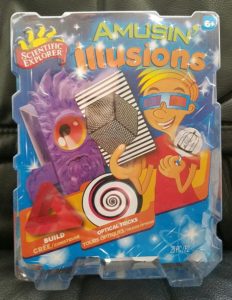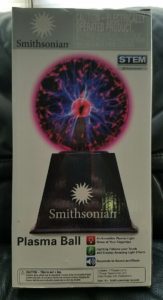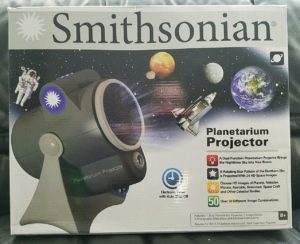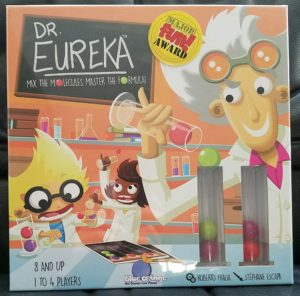With everyone talking about STEM these days, we here at Parents@Play are always on the lookout for great science-themed toys, games, and activities. Here are four that focus on vision that you and your family will love.
Amusin’ Illusions (Scientific Explorer)
 Optical illusions are always entertaining to play with, but haven’t you ever wondered how and why they work? How do 3D glasses get images to pop off the screen (or page)? Why do certain patterns seem to move even when we know they’re not? How does water make objects look like they’re bent? With this fun, educational kit you’ll have the answers to these and a number of other questions about visual conundrums. Amusin’ Illusions comes with a thoughtful and nicely illustrated instruction manual that takes you through the steps of building a number of illusions and explains the science behind each one. A great parent-child activity for ages 6+. Under $14 at your favorite retailer or www.alexbrands.com
Optical illusions are always entertaining to play with, but haven’t you ever wondered how and why they work? How do 3D glasses get images to pop off the screen (or page)? Why do certain patterns seem to move even when we know they’re not? How does water make objects look like they’re bent? With this fun, educational kit you’ll have the answers to these and a number of other questions about visual conundrums. Amusin’ Illusions comes with a thoughtful and nicely illustrated instruction manual that takes you through the steps of building a number of illusions and explains the science behind each one. A great parent-child activity for ages 6+. Under $14 at your favorite retailer or www.alexbrands.com
Smithsonian Plasma Ball (NSI)
 This beautiful-to-look-at ball responds to sound, music, and touch and puts an amazing light show at your fingertip, literally. So what do you do with a plasma ball besides look at it? To start with, you can use it to learn—safely—about electricity (including making your own lightning and even charging your phone). If you’ve got a Star Wars fan around the house, you can create a light saber with your plasma ball and a long fluorescent blub. You’ll find some great videos on YouTube with lots of other tips, tricks, and lessons. The Ball plugs in so you don’t need batteries. The manufacturer says it’s for ages 14+, but if you’re there to supervise, younger kids can enjoy it too. Retails online and off for under $35.
This beautiful-to-look-at ball responds to sound, music, and touch and puts an amazing light show at your fingertip, literally. So what do you do with a plasma ball besides look at it? To start with, you can use it to learn—safely—about electricity (including making your own lightning and even charging your phone). If you’ve got a Star Wars fan around the house, you can create a light saber with your plasma ball and a long fluorescent blub. You’ll find some great videos on YouTube with lots of other tips, tricks, and lessons. The Ball plugs in so you don’t need batteries. The manufacturer says it’s for ages 14+, but if you’re there to supervise, younger kids can enjoy it too. Retails online and off for under $35.
Smithsonian Planetarium Projector (NSI)
 This dual-function projector brings the nighttime sky in all its glory, right into your room. The larger projector shows the northern sky and can be rotated to match what you can see outside (assuming there isn’t too much light pollution). The smaller projector uses three discs to show a total of 24 images, which you can project individually or in combinations. These include the planets, some natural celestial phenomena (nebulae, galaxies, asteroids, and more), and human-made items (satellite, lunar orbiter, space shuttle, and more). The Planetarium Projector definitely feels like a toy, but it’s great for learning about constellations and a lot of other cool astrological stuff. You’ll need three AA batteries (not included) and about three minutes for assembly. It’s for ages 8+ and retails for under $40.
This dual-function projector brings the nighttime sky in all its glory, right into your room. The larger projector shows the northern sky and can be rotated to match what you can see outside (assuming there isn’t too much light pollution). The smaller projector uses three discs to show a total of 24 images, which you can project individually or in combinations. These include the planets, some natural celestial phenomena (nebulae, galaxies, asteroids, and more), and human-made items (satellite, lunar orbiter, space shuttle, and more). The Planetarium Projector definitely feels like a toy, but it’s great for learning about constellations and a lot of other cool astrological stuff. You’ll need three AA batteries (not included) and about three minutes for assembly. It’s for ages 8+ and retails for under $40.
Dr. Eureka Mix the Molecules (Blue Orange)
 After you’ve learned about optical illusions, made your own lightning, and gazed at the stars, you deserve a break. So get the family together and get ready for some brain-teasing fun. Despite the name, Dr. Eureka isn’t really about science concepts, but it is about thinking. Each person (the game is for 1 to 4 players) has three test tubes and six colored “molecules” (two each of red, green, and purple). Put a matching pair of molecules in each tube. Then turn over a challenge card, which has a picture of how the molecules should end up. Then all you do is race the other players to make your test tubes look like the ones on the card. It’s simple. Except for the part about not being able to touch the molecules with your hands—you have to pour them back and forth until you achieve the desired result. It’s for ages 8+ and costs under $40. http://www.blueorangegames.com
After you’ve learned about optical illusions, made your own lightning, and gazed at the stars, you deserve a break. So get the family together and get ready for some brain-teasing fun. Despite the name, Dr. Eureka isn’t really about science concepts, but it is about thinking. Each person (the game is for 1 to 4 players) has three test tubes and six colored “molecules” (two each of red, green, and purple). Put a matching pair of molecules in each tube. Then turn over a challenge card, which has a picture of how the molecules should end up. Then all you do is race the other players to make your test tubes look like the ones on the card. It’s simple. Except for the part about not being able to touch the molecules with your hands—you have to pour them back and forth until you achieve the desired result. It’s for ages 8+ and costs under $40. http://www.blueorangegames.com
